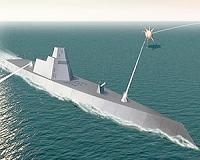| . |  |
. |
Dahlgren VA (SPX) Oct 01, 2010 Tests of the U.S. Navy's Maritime Laser Demonstration (MLD) system conducted recently at the Potomac River Test Range confirmed the laser weapon system's readiness to proceed with at-sea testing later this year, according to Northrop Grumman Corporation. Operating from a fixed site on land, the MLD weapon system fired a laser beam at a number of stationary targets, including representative small boat sections, across the Potomac River, company executives said. The laser burned through small boat sections in these tests, conducted in late August and early September. "We have shown that the Maritime Laser Demonstrator's design is as lethal at longer ranges as other previously demonstrated approaches," said Steve Hixson, vice president of Advanced Concepts, Space and Directed Energy Systems for Northrop Grumman's Aerospace Systems sector. "We have optimized the Maritime Laser Demonstrator's design to make it much more lethal at longer ranges while using less laser power than other approaches. "This means we can defeat threats at longer ranges using less electric power from a ship and with a smaller, more affordable weapon," Hixson noted. "This successful test series, coupled with the successful shore tracking tests earlier this year, give us confidence that we will be successful at the at sea demonstrator scheduled later this year." According to Hixson, the MLD laser weapon is based on mature technologies developed through several Defense Department programs, such as the precision tracking system from the Tactical High Energy Laser (THEL), which destroyed some 46 rockets, artillery and mortars in flight. The MLD laser weapon also features the high-brightness, solid-state laser technology from the Joint High Power Solid State Laser (JHPSSL) program, which was provided by the Office of the Secretary of Defense, High Energy Laser Joint Technology Office, Arlington, Va., and the U.S. Army Space and Missile Defense Command/Army Forces Strategic Command, Huntsville, Ala. Northrop Grumman was the prime contractor for THEL and JHPSSL. Northrop Grumman is developing MLD for the Office of Naval Research with a goal of demonstrating the readiness of solid-state laser weapon systems to begin transition to the fleet to engage targets that challenge current defensive systems such as swarms of enemy fast patrol boats. The "static land" tests were conducted at the Naval Surface Warfare Center's Dahlgren, Va., Division, where it operates the Potomac River Test Range, the nation's largest, fully-instrumented, over-the-water firing range. Such tests in marine or coastal conditions are essential because weapon systems and sensors function differently over water than over land. "Unlike commercial lasers that form the core of some laser systems intended for use at sea, MLD's power levels can be scaled to 100 kilowatts and beyond to defend ships from a wider variety of threats," according to Dan Wildt, vice president, Directed Energy Systems for Northrop Grumman. MLD is a multiple kilowatt, high-energy system for the purposes of the current demonstration phase. "Another advantage of our approach is a modular architecture system that makes upgrades easy as subsystem technology advances. This allows MLD to use any laser," Wildt added. "Competing approaches are performance-limited by their use of gun-mounted beam directors, commercial lasers and less accurate tracking systems."
Share This Article With Planet Earth
Related Links Northrop Grumman Learn about laser weapon technology at SpaceWar.com
 Boeing Receives Task Order For Design Of Free Electron Laser Lab Demonstrator
Boeing Receives Task Order For Design Of Free Electron Laser Lab DemonstratorAlbuquerque NM (SPX) Sep 14, 2010 Boeing has received an additional task order of $23 million to complete the design of the 100-kilowatt Free Electron Laser (FEL) lab demonstrator. The order is part of a U.S. Navy contract, valued at up to $163 million, which is the result of a competitive downselect based on preliminary designs provided in March. "The Free Electron Laser program will enable Navy ships to defend themselves ... read more |
|
| The content herein, unless otherwise known to be public domain, are Copyright 1995-2010 - SpaceDaily. AFP and UPI Wire Stories are copyright Agence France-Presse and United Press International. ESA Portal Reports are copyright European Space Agency. All NASA sourced material is public domain. Additional copyrights may apply in whole or part to other bona fide parties. Advertising does not imply endorsement,agreement or approval of any opinions, statements or information provided by SpaceDaily on any Web page published or hosted by SpaceDaily. Privacy Statement |